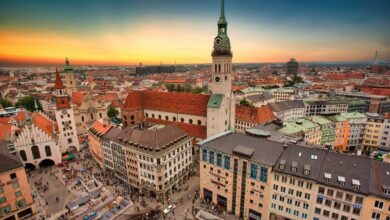This Mediterranean city is the Paris of the Middle East

For most Europeans, the Mediterranean evokes the sun-soaked coastlines of Italy, France, Greece and Spain. But does this neglect one of its best destinations?
Though Lebanon’s capital, Beirut, has long suffered instability, it was once hailed as the Paris of the Middle East. Resilient in the face of conflict and disaster, the city maintains a raw energy powered by its fusion of modern and old.
Here’s where to explore modern shopping districts and buzzing nightlife in this underrated city.
Modern malls and high-end residences rise among Beirut’s war remnants
When you head downtown to Beirut Souks, don’t expect the jumble and chaos of Marrakech.
Partially designed by the Pritzker Prize-winning Spanish architect, Rafael Moneo, this al fresco shopping district opened in 2009. It replaces the souk that was destroyed in the Lebanese Civil War, which lasted from 1975 until 1990 with Beirut at the heart of the conflict.
Contemporary design meets traditional architecture in the souks, injecting modernity into the historic district while nodding to its past.
As you peruse the rows of high-end international brands, you’ll see why Beirut has developed a reputation as a regional fashion hub.
Close by, in Beirut’s Central District, is the upscale neighbourhood of Saifi Village. It is abuzz with boutiques, bars, galleries and farmers markets that take over French-colonial style buildings.
These were reconstructed after the civil war, during which Saifi Village sat along the ‘Green Line’, the no-man’s land that divided the city. Today, the sniper’s nests have been renovated into homes with warm-coloured facades.
Remnants of the civil war remain throughout the city – not in museums but in plain sight. A visit to the ruins of Beirut’s Holiday Inn, which was at the heart of the ‘Battle of the Hotels’, is a chilling reminder of how recent, and personal, this conflict is to the locals.
To learn about the city’s more distant history, head to the behemoth National Museum of Beirut. It is packed with Lebanese artefacts dating from prehistoric times all the way through the different eras and 15 empires that the city lived under.
From mosques to beer bars, tradition and modernity coexist in Beirut
Religion plays an important role in Beirut’s identity, and there are countless beautiful churches and mosques to visit. Not to be missed, the blue-domed, Ottoman-style Mohammad Al-Amin Mosque is flanked by 65-metre-high minarets and is architecturally stunning.
Right next door is the Greek Orthodox Cathedral of St. George, the oldest active church in Beirut. The cathedral’s interior is where it really comes alive, with colourful frescoes and gold accents encased in a classical orthodox exterior – also restored after the civil war. Deep below in the crypt, you’ll find a wealth of architectural finds.
Just 10 minutes’ walk from the cathedral, you can wander the bohemian Gemmayzeh neighbourhood, a buzzing world of pubs, bars, restaurants and cafes.
It’s a great place to try the local beer, and wind down with friendly locals among the narrow streets and old French-era buildings.
Only a stone’s throw away is the L’Escalier de L’Art, a 500-metre uphill staircase that connects Rue Gouraud and Rue Sursock. As the name suggests, the staircase has held a number of art exhibitions since 1973.
Beirut has a vibrant music and party scene
It might surprise you that Beirut also has a vibrant music scene. Take a trip outside the city to discover some truly unique venues.
Drive 42km past beach resorts and high-rises into the green of the Chouf Mountains, where you’ll find the Beiteddine Palace set among orchards and terraced gardens. With its stunning blend of Italian and Arab baroque, it’s easy to see why the Ottoman Governor, Emir Bashir Chehab II, made this his residence.
Completed in 1818, it has continued to play a vital role in Lebanon’s political history over the years – but today, it hosts the famed Beiteddine Festival. The event traditionally attracts international talents from the opera and classical world, but has also welcomed artists like Elton John, Mariah Carey, Phil Collins, UB40 and others.
Don’t feel like driving? Beirut’s nightlife won’t disappoint. Dance music is popular in the city, and things really kick off in the summer with international DJs making their rounds.
Venues like SKYBAR, The Ballroom Blitz, and practically any of the clubbing institutions within the BIEL Waterfront have earned Beirut status as a party hub. It even ranked third in CNN’s 2019 list of the world’s best party cities.
Where to get Beirut’s best falafel
Any local will tell you that one of the best things about being Lebanese is the food. The country’s coastal climate lends itself to fresh, fragrant and colourful dishes, with centuries of history embodied in each one.
Must-tries include sfiha (flatbread cooked with a minced meat topping), tabbouleh (Levantine chopped parsley salad), manakish (dough topped with thyme, cheese, or ground meat), kibbeh (Levantine croquettes) and knafeh (spun pastry dessert), to name only a few.
As for where to sample Beirut’s best food, local recommendations include Barbar in Hamra for sandwiches and M Sahyoun on Damascus Road for falafel. If you think you’re seeing double on arrival, don’t go and get your eyes checked just yet.
Two Falafel Sahyouns stand side by side – owned by two brothers who are engaged in a bitter, long-standing feud. Even though the menus are practically the same, these two restaurants have legendary status within Beirut, with incredible falafel that have the locals divided.
By now, you’ve seen how much Beirut has to offer. This is a city with history, culture, religion and modern appeal.
But it’s the city’s energy that really stands out. The people are friendly. The pace is fast. There’s always something to do. However you choose to spend your time here, your senses will surely be stimulated.
Read the full article here








